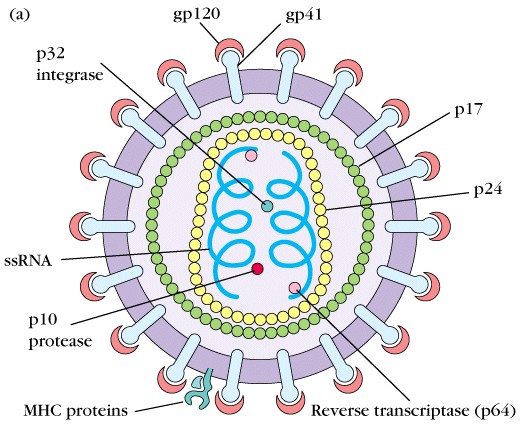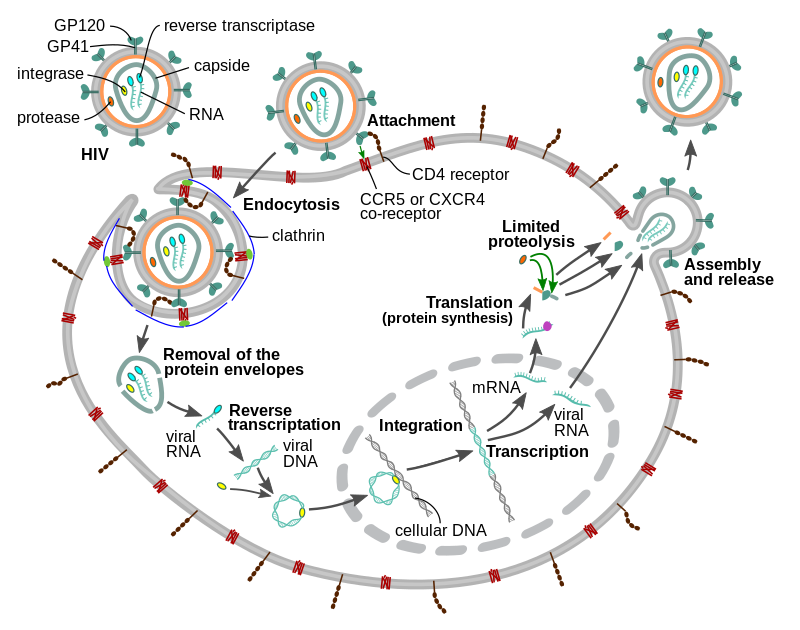8.3 AIDS
8.3 AIDS
- The word AIDS stands for Acquired Immuno Deficiency Syndrome.
- This means deficiency of immune system, acquired during the lifetime of an individual indicating that it is not a congenital disease. ‘Syndrome’ means a group of symptoms.
- AIDS was first reported in 1981 and in the last twenty-five years or so, it has spread all over the world killing more than 25 million persons.
- AIDS is caused by the Human Immuno deficiency Virus (HIV), a member of a group of viruses called retrovirus, which have an envelope enclosing the RNA genome.
Human Immuno deficiency Virus (HIV) Structure & its Genome:
- It is roughly spherical with a diameter of about
120 nm, around
60 times smaller than a red blood cell.
- It is composed of two copies of positive-sense single-stranded RNA that codes for the virus's nine genes enclosed by a conical capsid composed of 2,000 copies of the viral
protein p24.
- The single-stranded RNA is tightly bound to nucleocapsid
proteins, p7, and enzymes needed for the development of the virion such
as reverse transcriptase, proteases, ribonuclease and integrase.
- A matrix composed of the viral protein p17 surrounds the
capsid ensuring the integrity of the virion particle.
- This is, in turn, surrounded by the viral envelope, that is composed of the lipid bilayer taken from the membrane of a human host cell when the newly formed virus particle buds from the cell.
- The viral envelope contains proteins from the host cell and relatively few copies of the HIV Envelope protein, which consists of a cap made of three molecules known as glycoprotein (gp) 120, and a stem consisting of three gp41 molecules that anchor the structure into the viral envelope.
- Major histocompatibility complex (MHC): group of genes that code for proteins found on the
surfaces of cells that help the immune system recognize foreign substances.

Protein name & position
|
Types
|
Matrix viral protein surrounds the capsid
|
p17
|
Nucleo-capsid proteins
|
p7
|
Envelope protein
|
glycoprotein (gp-120), and a stem consisting of
three gp-41 molecules
|
Integrase enzyme
|
p32
|
Protease
|
p10
|
conical capsid
|
p24
|
Reverse transcriptase
|
p64
|
Figure 8.6 Replication of retrovirus
- Entry to the cell (viral tropism): The HIV virion enters macrophages and CD4+ T cells by the adsorption of glycoproteins on its surface to receptors on the target cell followed by fusion of the viral envelope with the target cell membrane and the release of the HIV capsid into the cell. (CD- cluster of differentiation a receptor protein)

- Replication and transcription: Shortly after the viral capsid enters the cell, an enzyme called reverse transcriptase liberates the positive-sense single-stranded RNA genome from the attached viral proteins and copies it into a complementary DNA (cDNA) molecule.
- Recombination: Two RNA genomes are encapsidated in each HIV-1 particle (see Structure and genome of HIV). Upon infection and replication catalyzed by reverse transcriptase, recombination between the two genomes can occur.
- Assembly and release: The final step of the viral cycle, assembly of new HIV-1 virions, begins at the plasma membrane of the host cell. The Envelope poly-protein (gp160) goes through the endoplasmic reticulum and is transported to the Golgi apparatus where it is cleaved by furin resulting in the two HIV envelope glycoproteins, gp41 and gp120.
 |
| compare it with the diagram given in your text book |
Transmission of HIV-infection
generally occurs by
- (a) sexual contact with infected person,
- (b) by transfusion of contaminated blood and blood products,
- (c) by sharing infected needles as in the case of intravenous drug abusers and
- (d) from infected mother to her child through placenta.
- So, people who are at high risk of getting this infection includes - individuals who have multiple sexual partners, drug addicts who take drugs intravenously, individuals who require repeated blood transfusions and children born to an HIV infected mother.
- Do you know–when do people need repeated blood transfusion? Find out and make a list of such conditions.
- It is important to note that HIV/AIDS is not spread by mere touch or physical contact; it spreads only through body fluids.
- It is, hence, imperative, for the physical and psychological well-being, that the HIV/AIDS infected persons are not isolated from family and society.
- There is always a time-lag between the infection and appearance of AIDS symptoms.
- This period may vary from a few months to many years (usually 5-10 years).
- Window Period: The time between when a person is exposed to a bacteria or virus and when a test can accurately detect organism.
- Incubation Period: The time elapsed between exposure to a bacteria or virus and when symptoms and signs are first apparent.
- After getting into the body of the person, the virus enters into macrophages where RNA genome of the virus replicates to form viral DNA with the help of the enzyme reverse transcriptase.
- This viral DNA gets incorporated into host cell’s DNA and directs the infected cells to produce virus particles.
- The macrophages continue to produce virus and in this way acts like a HIV factory. Simultaneously, HIV enters into helper T-lymphocytes (TH ), replicates and produce progeny viruses.
- The progeny viruses released in the blood attack other helper T-lymphocytes.
- This is repeated leading to a progressive decrease in the number of helper T-lymphocytes in the body of the infected person.
- During this period, the person suffers from bouts of fever, diarrhoea and weight loss.
- Due to decrease in the number of helper T-lymphocytes, the person starts suffering from infections that could have been otherwise overcome such as those due to bacteria especially Mycobacterium, viruses, fungi and even parasites like Toxoplasma.
- The patient becomes so immuno-deficient that he/she is unable to protect himself/herself against these infections.
- A widely used diagnostic test for AIDS is enzyme linked immuno-sorbent assay (ELISA). Treatment of AIDS with anti-retroviral drugs is only partially effective.
Drug Class
|
Generic Name (Other names and acronyms)
|
Brand Name
|
NRTIs block reverse transcriptase, an enzyme HIV needs
to make copies of itself.
|
emtricitabine (FTC)
|
Emtriva
|
lamivudine (3TC)
|
Epivir
|
|
tenofovir disoproxil fumarate (tenofovir DF, TDF)
|
Viread
|
|
zidovudine (azidothymidine, AZT, ZDV)
|
Retrovir
|
- NRTIs: Nucleotide/Nucleoside Reverse Transcriptase Inhibitors
- They can only prolong the life of the patient but cannot prevent death, which is inevitable.
- Prevention of AIDS : As AIDS has no cure, prevention is the best option.
- Moreover, HIV infection, more often, spreads due to conscious behaviour patterns and is not something that happens inadvertently, like pneumonia or typhoid.
- Of course, infection in blood transfusion patients, new-borns (from mother) etc., may take place due to poor monitoring.
- The only excuse may be ignorance and it has been rightly said – “don’t die of ignorance”.
- In our country the National AIDS Control Organisation (NACO) and other non-governmental organisation (NGOs) are doing a lot to educate people about AIDS.
- WHO has started a number of programmes to prevent the spreading of HIV infection.
- Making blood (from blood banks) safe from HIV, ensuring the use of only disposable needles and syringes in public and private hospitals and clinics, free distribution of condoms, controlling drug abuse, advocating safe sex and promoting regular check-ups for HIV in susceptible populations, are some such steps taken up.
- Infection with HIV or having AIDS is something that should not be hidden – since then, the infection may spread to many more people.
- HIV/AIDS-infected people need help and sympathy instead of being shunned by society.
- Unless society recognises it as a problem to be dealt with in a collective manner – the chances of wider spread of the disease increase manifold.
- It is a malady that can only be tackled, by the society and medical fraternity acting together, to prevent the spread of the disease.
Comments
Post a Comment